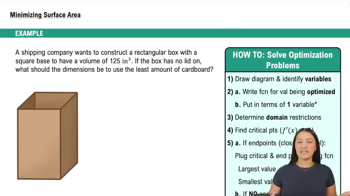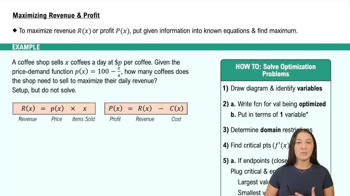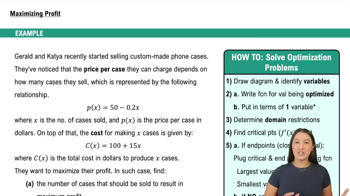Table of contents
- 0. Functions7h 52m
- Introduction to Functions16m
- Piecewise Functions10m
- Properties of Functions9m
- Common Functions1h 8m
- Transformations5m
- Combining Functions27m
- Exponent rules32m
- Exponential Functions28m
- Logarithmic Functions24m
- Properties of Logarithms34m
- Exponential & Logarithmic Equations35m
- Introduction to Trigonometric Functions38m
- Graphs of Trigonometric Functions44m
- Trigonometric Identities47m
- Inverse Trigonometric Functions48m
- 1. Limits and Continuity2h 2m
- 2. Intro to Derivatives1h 33m
- 3. Techniques of Differentiation3h 18m
- 4. Applications of Derivatives2h 38m
- 5. Graphical Applications of Derivatives6h 2m
- 6. Derivatives of Inverse, Exponential, & Logarithmic Functions2h 37m
- 7. Antiderivatives & Indefinite Integrals1h 26m
- 8. Definite Integrals4h 44m
- 9. Graphical Applications of Integrals2h 27m
- 10. Physics Applications of Integrals 2h 22m
5. Graphical Applications of Derivatives
Applied Optimization
Problem 4.5.11
Textbook Question
Maximum-area rectangles Of all rectangles with a perimeter of 10, which one has the maximum area? (Give the dimensions.)
 Verified step by step guidance
Verified step by step guidance1
Start by understanding the relationship between the perimeter and the dimensions of a rectangle. The perimeter P of a rectangle with length l and width w is given by the formula: <math xmlns="http://www.w3.org/1998/Math/MathML"><mrow><mi>P</mi><mo>=</mo><mn>2</mn><mo>(</mo><mi>l</mi><mo>+</mo><mi>w</mi><mo>)</mo></mrow></math>. Since the perimeter is 10, we have: <math xmlns="http://www.w3.org/1998/Math/MathML"><mrow><mn>2</mn><mo>(</mo><mi>l</mi><mo>+</mo><mi>w</mi><mo>)</mo><mo>=</mo><mn>10</mn></mrow></math>.
Solve the perimeter equation for one of the variables, say w. From <math xmlns="http://www.w3.org/1998/Math/MathML"><mrow><mn>2</mn><mo>(</mo><mi>l</mi><mo>+</mo><mi>w</mi><mo>)</mo><mo>=</mo><mn>10</mn></mrow></math>, we get: <math xmlns="http://www.w3.org/1998/Math/MathML"><mrow><mi>l</mi><mo>+</mo><mi>w</mi><mo>=</mo><mn>5</mn></mrow></math>. Therefore, <math xmlns="http://www.w3.org/1998/Math/MathML"><mrow><mi>w</mi><mo>=</mo><mn>5</mn><mo>-</mo><mi>l</mi></mrow></math>.
Express the area A of the rectangle in terms of l. The area A is given by: <math xmlns="http://www.w3.org/1998/Math/MathML"><mrow><mi>A</mi><mo>=</mo><mi>l</mi><mo>×</mo><mi>w</mi></mrow></math>. Substitute the expression for w from the previous step: <math xmlns="http://www.w3.org/1998/Math/MathML"><mrow><mi>A</mi><mo>=</mo><mi>l</mi><mo>×</mo><mo>(</mo><mn>5</mn><mo>-</mo><mi>l</mi><mo>)</mo></mrow></math>.
Simplify the expression for the area: <math xmlns="http://www.w3.org/1998/Math/MathML"><mrow><mi>A</mi><mo>=</mo><mn>5</mn><mi>l</mi><mo>-</mo><msup><mi>l</mi><mn>2</mn></msup></mrow></math>. This is a quadratic function in terms of l, which can be written as: <math xmlns="http://www.w3.org/1998/Math/MathML"><mrow><mi>A</mi><mo>=</mo><mo>-</mo><msup><mi>l</mi><mn>2</mn></msup><mo>+</mo><mn>5</mn><mi>l</mi></mrow></math>.
Find the value of l that maximizes the area. Since the quadratic function <math xmlns="http://www.w3.org/1998/Math/MathML"><mrow><mi>A</mi><mo>=</mo><mo>-</mo><msup><mi>l</mi><mn>2</mn></msup><mo>+</mo><mn>5</mn><mi>l</mi></mrow></math> is a downward-opening parabola, its maximum value occurs at the vertex. The vertex of a quadratic function <math xmlns="http://www.w3.org/1998/Math/MathML"><mrow><mi>ax</mi><mo>+</mo><mi>bx</mi><mo>+</mo><mi>c</mi></mrow></math> is given by <math xmlns="http://www.w3.org/1998/Math/MathML"><mrow><mo>-</mo><mi>b</mi><mo>/</mo><mn>2</mn><mi>a</mi></mrow></math>. Here, <math xmlns="http://www.w3.org/1998/Math/MathML"><mrow><mi>a</mi><mo>=</mo><mo>-</mo><mn>1</mn></mrow></math> and <math xmlns="http://www.w3.org/1998/Math/MathML"><mrow><mi>b</mi><mo>=</mo><mn>5</mn></mrow></math>, so calculate <math xmlns="http://www.w3.org/1998/Math/MathML"><mrow><mo>-</mo><mn>5</mn><mo>/</mo><mo>(</mo><mn>2</mn><mo>×</mo><mo>-</mo><mn>1</mn><mo>)</mo></mrow></math> to find the optimal length l.
 Verified video answer for a similar problem:
Verified video answer for a similar problem:This video solution was recommended by our tutors as helpful for the problem above
Video duration:
4mPlay a video:
Was this helpful?
Key Concepts
Here are the essential concepts you must grasp in order to answer the question correctly.
Perimeter
Perimeter is the total distance around a two-dimensional shape. For rectangles, the perimeter (P) is calculated using the formula P = 2(length + width). In this problem, the perimeter is fixed at 10, which means the sum of the length and width must equal 5, allowing us to express one dimension in terms of the other.
Recommended video:

Example 4: Norman Window
Area of a Rectangle
The area of a rectangle is calculated by multiplying its length (l) by its width (w), expressed as A = l * w. To find the rectangle with the maximum area under a fixed perimeter, we need to express the area in terms of a single variable, which can be done by substituting the width with a function of the length derived from the perimeter constraint.
Recommended video:

Estimating the Area Under a Curve Using Left Endpoints
Optimization
Optimization in calculus involves finding the maximum or minimum values of a function. In this context, we will use techniques such as taking the derivative of the area function and setting it to zero to find critical points. This will help us determine the dimensions of the rectangle that yield the maximum area while adhering to the given perimeter constraint.
Recommended video:

Intro to Applied Optimization: Maximizing Area

 1:13m
1:13mWatch next
Master Intro to Applied Optimization: Maximizing Area with a bite sized video explanation from Callie
Start learningRelated Videos
Related Practice







